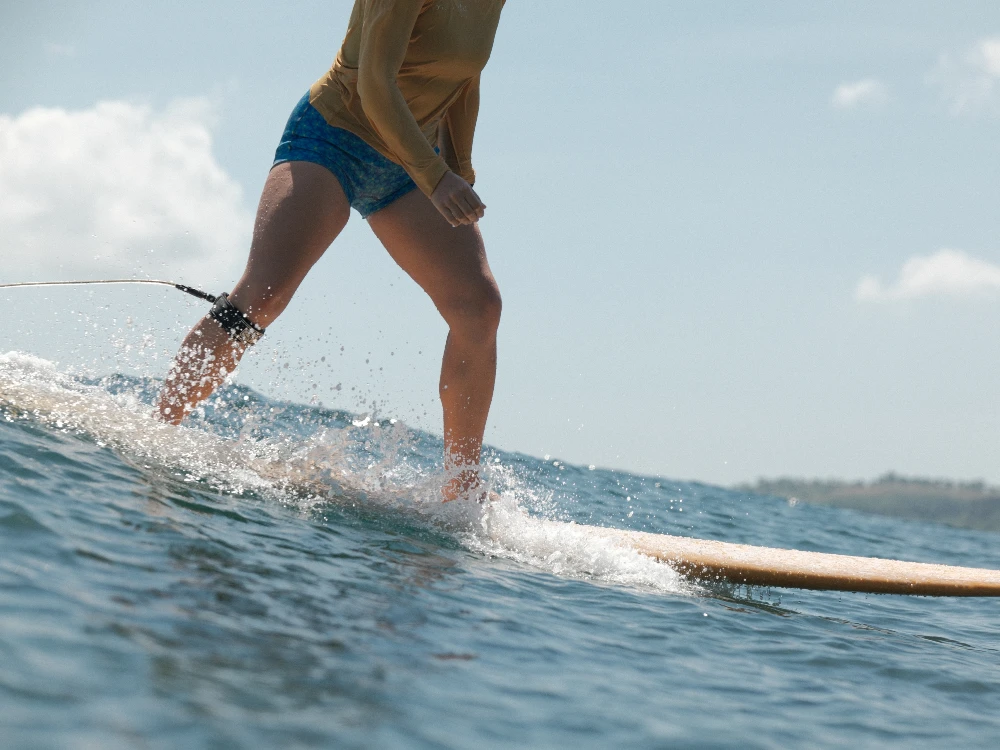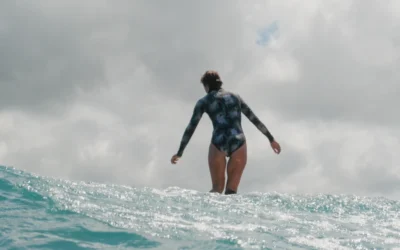Ever heard the quote that the best surfer is the one having the most fun?
This might fly for surf schools focused on churning through bulk students during school or university holidays, but it’s not entirely true. In our experience, the quote should actually say that the calmest and most relaxed surfer is the one having the most fun.
Having fun is a result of feeling safe and confident in your surroundings. And in an activity like surfing that’s full of unpredictability, being relaxed helps you catch more waves and ultimately connect with the ocean on a deeper level.
Getting in a calm and relaxed state as wave after wave bears down on you, however, is almost unthinkable as a beginner…
Unless you have a solid grasp of surf safety protocols, that is.
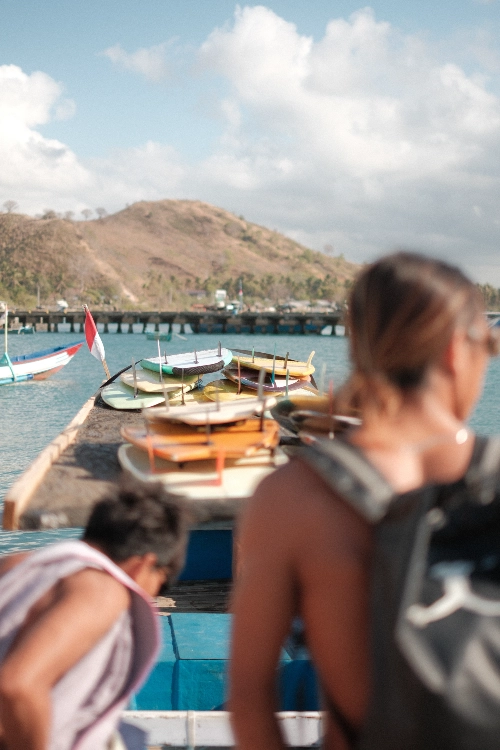
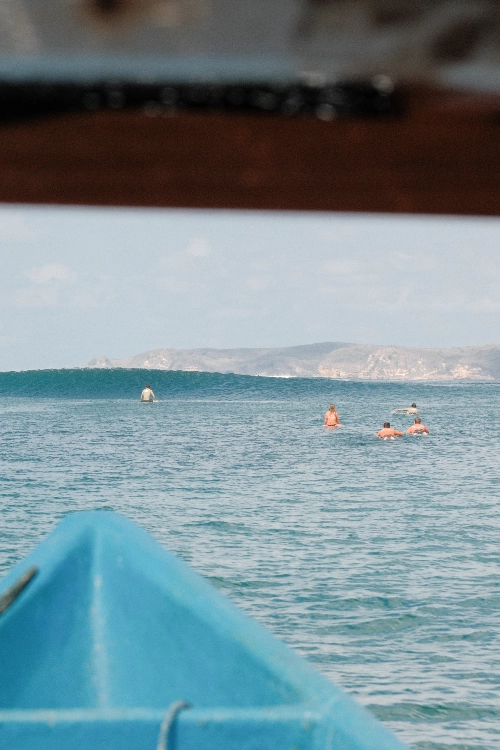
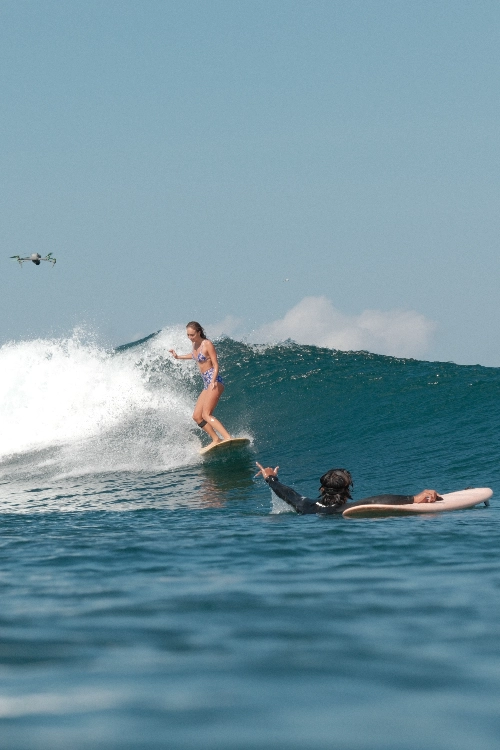
Why are surfing safety tips important?
Feeling safe in the water isn’t only about preventing harm to yourself and others.
It also ensures that you feel more comfortable in what is otherwise a very unfamiliar environment.
When you’re just starting out, the ocean seems like a daunting and intimidating place. Knowing how to keep yourself safe gives you more confidence to paddle out, face those waves and maybe even grow as a human being.
We always say that a beginner with a high surf IQ (gleaned through articles like this and with expert guidance) is better equipped to handle the ocean than more seasoned wave riders whose safe surfing knowledge is lacking.
Safety guidelines and respect for both the ocean and your fellow surfers is therefore doubly beneficial: you minimise the risk of injury in the water while also progressing faster and with more confidence.
What are the best surf safety tips for beginners?
So, what are the best surf etiquette and surfing safety tips?
After coaching literally thousands of guests, all of whom are inexperienced surfers riding waves for the first time, we’ve come up with a few tips to ensure the best possible experience for you, your instructor and fellow surfers.
Avoid potential hazards, stay cool in crowded lineups and find the perfect wave for your skill level by following these insights.
Do I need to prepare for surf yoga retreats?
Besides making sure you pack properly for your destination, there’s not much you need to prepare for.
You could always do at-home exercises, sharpen your surfing skills or ramp up your yoga classes. But really, retreats cater to all levels of experience and ability, so come as you are.
You’ll have an amazing time no matter whether you already surf or practice yoga. And with everything you need for an epic holiday already provided, you can focus on simply relaxing and having fun.
Don’t attach your leg rope/leash before reaching the shore
Before you can catch waves and call yourself a surfer, you need to reach the water. And while this might sound like a trivial point covered in every beginner’s lesson, it’s a low-key important one.
Your legrope (or leash) is the cord that connects you and your board, ensuring that your ride doesn’t end with a long swim back to shore.
You’ll need to attach it securely to your ankle before entering the water. However, many beginners make the mistake of putting their leg rope on before even reaching the shore. This not only makes it difficult to walk on the sand, but it also increases your chances of tripping and falling over.
Don’t put your legrope on till right before you paddle out.
Take it from our own personal experiences… face-planting in the sand in front of a crowd of experienced surfers is not the best way to start your surfing journey.
Learn the golden rules of surf etiquette (but go easy on yourself if you break them)
Did you know that there exists an unspoken “code of conduct” among surfers in the water?
This is known as surf etiquette and it’s essential for maintaining order and safety in the lineup. Some common rules include:
- Respect the right of way: The surfer closest to the peak or who is already riding the wave has the right of way. Don’t “drop in” on them
- Paddle wide and never straight towards other surfers: This avoids potential collisions and ensures everyone has space to catch waves
- Communicate: Call out to communicate with other surfers
While these rules may seem overwhelming at first, don’t beat yourself up if you break them as a beginner. It’s natural to make mistakes when learning.A qualified surf guide will also educate you on these before you paddle out, so don’t feel like you need to study them in-depth before booking a learn-to-surf trip.
Trust your gut
There’s actual science that says that trusting your gut can lead to better decisions.
While this is important in everyday life, it’s especially crucial when surfing. Your intuition and instincts are often right when it comes to reading the ocean and assessing potential dangers.
If you feel uncomfortable or unsafe when looking at the waves, err on the side of caution.
To stay safe is to be mindful, and things like a rip current, varying water depth or unpredictable wave size can all be potential hazards that your instinct picks up on.
So, when in doubt, trust your gut.
It tends to keep you safe… or at least lead you to Lombok’s best restaurants.
Be mindful of other surfers
Being mindful of your fellow surfers is one of the most important things to keep in mind.
While there are amazing beginner-only surf zones where you’ll be surrounded by others learning to surf, most of the time you’ll be sharing the waves with more experienced surfers.
This is nothing to be intimidated by, as even more experienced surfers (especially on Lombok) are cool in the lineup.
You should, however, be mindful of those around you when in the water.
This means not paddling in front of someone who is already riding a wave, never bailing (throwing away) your surfboard when there’s someone behind you and generally respecting others’ space in the lineup.
Wear the right surf attire
Surfing IQ is about staying safe, but it’s also about wearing the right attire.
This doesn’t mean you need to wear expensive or trendy surf gear, but it does mean wearing the right clothing for your protection and comfort.
What do you feel comfortable wearing? Does your attire match the conditions? Are you properly protected from the sun?
Surfing is physically demanding, and if women can get away with wearing a comfortable, flexible swimsuit that protects from the elements, go for it.
Likewise for men, you might want to consider investing in a pair of surf-specific board shorts and wetsuit top/rash guard to stay limber yet warm.
Surfing requires a lot of movement, so whatever you choose to wear, make sure it’s comfortable, condition-suitable and unrestrictive as can be.
Never surfed before? Book a surf lesson with accredited coaches
There’s an abundance of information you can learn from articles like this and even Instagram, but there’s no substitute for learning from an experienced, accredited surf coach.
Everything from wave patterns to marine life, what good waves look like and how to negotiate a line-up are covered, making a surf school or surf retreat lesson a cheat code for faster surf progression.
Besides, learning from an experienced surfer or surf school will instil good habits and valuable insights that you may not have learned otherwise.
You also get to meet and surf with other members of the beginner surf community, making it a fun and social experience.
Follow the crowd
If you’re only new to surfing, identifying breaking waves, beginner friendly spots and surfing safely can all be hard concepts to grasp.
The easiest way to overcome these challenges, and get the most out of your surf trip or lesson, is to follow a crowd.
Watching experienced surfers gives you a good idea of whether the waves are suitable for your skills.
If experienced surfers are struggling to reach the lineup or falling regularly, chances are it’s not the best spot for beginners.
Likewise, if you see other surfers of a similar skill level to you paddling out and catching waves with ease, feel free to follow them.
Observation is a powerful tool for any rookie surfer sussing a new spot. Take the time to watch others before diving in yourself.
Apply sunscreen before surfing (but wipe your hands after)
If there’s one thing that separates an experienced surfer from a learner, it’s the little subtleties.
One of these is applying sunscreen before you get in the water and wiping your hands after.
Why?
Because sun protection like sunscreen, while perfect for preventing skin cancer, is responsible for more blown takeoffs and failed pop-ups than nerves ever were.
Think about it. You could have the right board, be riding the right surf spot and ready to have all the fun in the world. If you’ve got sunscreen on your hands, though, you’re more likely to slip off the board.
Give yourself every opportunity to ride the wave of your life.
Apply sunscreen or zinc… then wipe it off your hands.
Final thoughts
Safe surfing is as much about being respectful at different surf spots, surfing safely and basic surf knowledge as it is about connecting more deeply with the experience. Keep this article handy during your next trip and we guarantee you’ll have more fun in the water!

